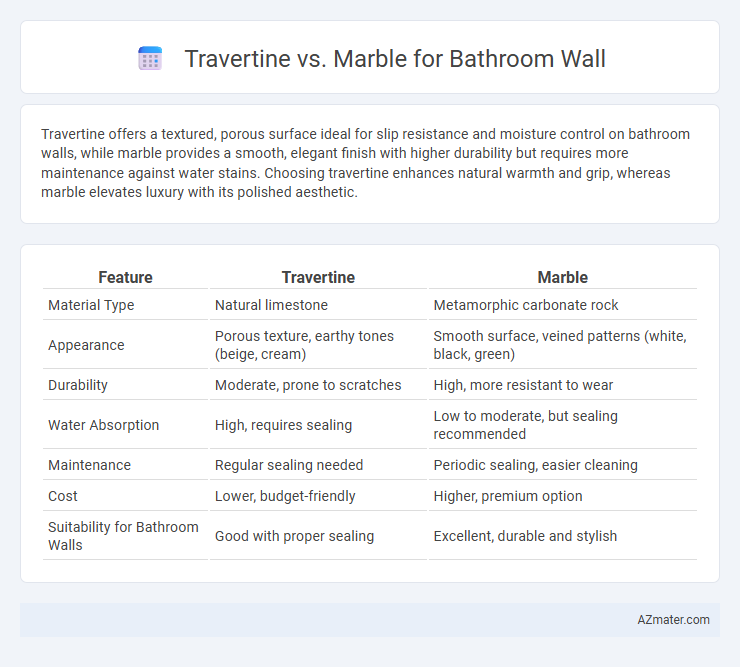Travertine offers a textured, porous surface ideal for slip resistance and moisture control on bathroom walls, while marble provides a smooth, elegant finish with higher durability but requires more maintenance against water stains. Choosing travertine enhances natural warmth and grip, whereas marble elevates luxury with its polished aesthetic.
Table of Comparison
| Feature | Travertine | Marble |
|---|---|---|
| Material Type | Natural limestone | Metamorphic carbonate rock |
| Appearance | Porous texture, earthy tones (beige, cream) | Smooth surface, veined patterns (white, black, green) |
| Durability | Moderate, prone to scratches | High, more resistant to wear |
| Water Absorption | High, requires sealing | Low to moderate, but sealing recommended |
| Maintenance | Regular sealing needed | Periodic sealing, easier cleaning |
| Cost | Lower, budget-friendly | Higher, premium option |
| Suitability for Bathroom Walls | Good with proper sealing | Excellent, durable and stylish |
Introduction to Travertine and Marble for Bathroom Walls
Travertine and marble are popular natural stone choices for bathroom walls, prized for their durability and luxurious appearance. Travertine features a porous texture with natural pits and veins, offering a rustic and warm aesthetic ideal for creating a spa-like atmosphere. Marble, known for its smooth surface and elegant veining patterns, provides a classic, high-end look that enhances the brightness and sophistication of bathroom interiors.
Key Differences Between Travertine and Marble
Travertine and marble differ significantly in texture and porosity, with travertine displaying a porous, matte finish while marble offers a smoother, polished surface ideal for bathroom walls. Travertine's natural pitting requires sealing to prevent moisture absorption, making it more susceptible to stains compared to the denser, less porous marble. Cost-wise, travertine typically provides a more affordable option, whereas marble's luxurious appearance and durability command a higher price point in bathroom wall applications.
Aesthetic Appeal: Color and Texture Comparisons
Travertine offers a warm, earthy palette with natural pitted textures that create a rustic yet elegant bathroom wall aesthetic, while marble features a polished, smooth surface with distinctive veining patterns that convey luxury and sophistication. The color range of travertine spans beige, cream, and soft browns, complementing neutral or Mediterranean styles, whereas marble presents striking options like white Carrara, black, and green varieties that enhance contemporary or classic designs. Texture differences make travertine ideal for non-slip wall finishes, contrasted with marble's sleek, reflective quality that brightens and visually expands bathroom spaces.
Durability and Longevity in Bathroom Environments
Travertine offers excellent durability in bathroom environments due to its natural porosity and resistance to moisture when properly sealed, making it less prone to cracking or chipping compared to marble. Marble, while admired for its luxurious appearance, is more susceptible to etching and staining from acidic substances, requiring regular maintenance to preserve longevity. Both stones can last decades in bathrooms with appropriate care, but travertine's resilience to moisture and wear often makes it a more practical choice for high-traffic, humid areas.
Water Resistance and Maintenance Requirements
Travertine and marble differ significantly in water resistance and maintenance when used for bathroom walls. Travertine is a porous natural stone requiring regular sealing to prevent water absorption and staining, while marble, though also porous, tends to be slightly less absorbent but demands careful maintenance to avoid etching and discoloration from bathroom products. Both materials need timely cleaning with pH-neutral cleaners to maintain their appearance and durability in a moist bathroom environment.
Cost Comparison: Travertine vs Marble
Travertine typically costs between $3 to $7 per square foot, making it a more affordable option compared to marble, which ranges from $10 to $30 per square foot depending on quality and source. Installation costs for both materials can vary, but marble often requires more specialized labor due to its fragility and weight, potentially increasing overall expenses. Considering maintenance, travertine's porous nature may lead to higher long-term sealing costs, whereas marble's durability can reduce upkeep costs despite its premium price.
Installation Process and Practical Considerations
Travertine requires more careful sealing and maintenance during installation due to its porous nature, making it prone to staining and water damage in bathroom walls. Marble, while denser and less porous, demands precise cutting and handling to avoid chipping and cracking, with installation generally requiring experienced professionals to ensure durability and proper moisture resistance. Both materials necessitate waterproof substrates and thorough sealing, but travertine's natural pits often need filling for smooth finishes, impacting overall installation time and cost.
Environmental Impact and Sustainability
Travertine and marble differ significantly in environmental impact and sustainability for bathroom walls, with travertine generally exhibiting a lower carbon footprint due to its abundant availability and less intensive quarrying processes. Marble extraction often involves higher energy consumption and landscape disruption, raising sustainability concerns compared to travertine's comparatively eco-friendly mining methods. Choosing travertine supports reduced environmental degradation and promotes a more sustainable material lifecycle for bathroom wall applications.
Best Use Cases for Travertine and Marble in Bathrooms
Travertine is ideal for bathroom walls due to its natural porous texture that offers excellent slip resistance and a warm, earthy aesthetic perfect for rustic or Mediterranean designs. Marble provides a luxurious, polished surface that resists moisture, making it well-suited for high-end, elegant bathroom interiors where a smooth, glossy finish is desired. Both materials require sealing for protection against moisture and staining, but travertine excels in creating textured, natural looks while marble is preferred for sleek, refined styles.
Final Recommendations: Which Material is Best for Your Bathroom Walls?
Travertine offers a porous texture with natural pits and veins, providing a rustic and warm aesthetic ideal for bathrooms with moderate moisture, while marble presents a sleek, dense surface that resists water absorption better but requires more maintenance to prevent staining. For high-humidity environments, marble is typically recommended due to its durability and ease of cleaning, whereas travertine suits bathrooms prioritizing natural, earthy designs and lower traffic. Choosing between these materials depends on balancing durability, maintenance tolerance, and the desired visual style for your bathroom walls.

Infographic: Travertine vs Marble for Bathroom Wall
 azmater.com
azmater.com